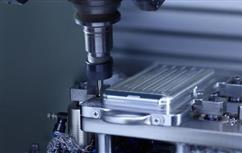关键词:
First-principles
Molecular dynamics
Chemical mechanical polishing
Ceria
Silica
Tribology
摘要:
We report a form of chemical mechanical polishing (CMP) in which ceria abrasive particles polish a silicon wafer surface in a water environment. The Car-Parrinello molecular dynamics (CPMD) method, which enables chemical reaction dynamics in non-equilibrium systems to be treated non-empirically, was used. The first application of CPMD was to a model including a silica surface rubbed by a ceria cluster to ascertain the fundamental tribochemical phenomena in the CMP process. The model consisted of a hydrogen-terminated silica surface (a representative model of an oxidized wafer surface) and H4Ce6O12 cluster placed in the vicinity of an asperity in the silica surface. H2O molecules were explicitly considered in order to reflect the presence of slurry water. An external load and shear force were applied to the cluster. Under conditions of finite temperature and friction, a Ce-O-Si bridging bond formed at the interface between the silica surface and the ceria cluster. Subsequently, another Ce-O-Si bridging bond formed. These newly formed bridging bonds changed the silicon atom into a five-coordinated one. Because this state was probably unstable, a pyramid structure was rapidly restored by breaking the original Si-O bond in the asperity, meaning that the wafer surface became flattened. By referring to static density functional theory (DFT) calculations, we concluded that this bond dissociation event was due to multiple Ce-O-Si bonds forming. To discuss the effect of slurry water, a similar CPMD simulation, but without H2O molecules (i.e., dry friction), was performed. Here, the Si-O bond dissociation reaction did not take place even if multiple Ce-O-Si bonds formed. This means slurry water is needed for CMP to occur and it probably helps to weaken the Si-O bond. The second application of CPMD was to a model consisting of a thin water layer sandwiched between silica and ceria plates for studying the effect of the surface orientation of the ceria. Two low-index CeO2 surfac
 欢迎来到三峡大学图书馆!
欢迎来到三峡大学图书馆!


